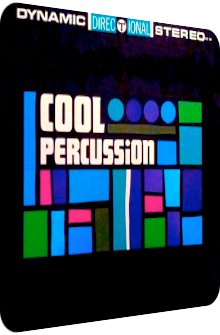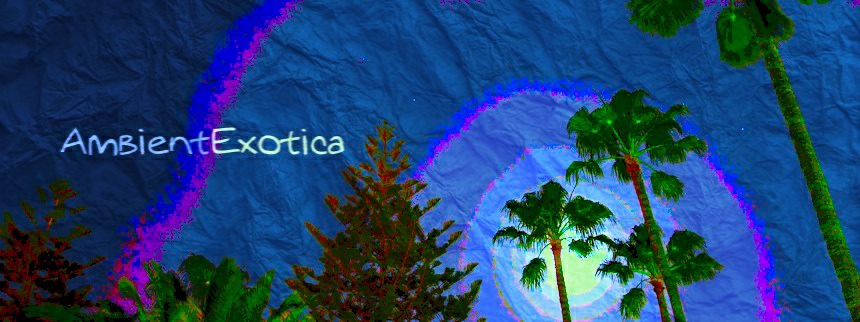
John Evans
Cool Percussion
1962
Cool Percussion is the final percussion-related work which Frans Bayetz (1914–2005) recorded under his pseudonym John Evans. It is released in 1962 on the Directional Sound label, a straight competitor to Enoch Light’s Command Records. Both labels were prone to intermix state of the art recording techniques with splendid melodies. The long explanations on these gatefold releases are usually a feast for audiophiles, but a staggering letdown for everyone else who wants to get a taste of the setting, the overarching topic, the amount of musicians and related information. And yet, John Evans succeeds with his 12 arrangements.
I hail the predecessor of Cool Percussion, called Exotic Percussion And Brilliant Brass (1961), as a masterful Exotica gold standard which devoted fans know, but no one else can get hold of due to its vinyl-only gestalt. Said predecessor featured cavalcades of drums and quirky instruments and enmeshed them with true-bred Exotica material. Heck, even the ever-strange drummer and savage Chaino is on board. On Cool Percussion, one thing is for sure though: Chaino is suspended until further note. No surprise, there is – I can tell you this much in advance – only one arrangement that sports some scent of a bongo. But apart from this incident which seems more like a figment than a real occurrence, frugality reigns, the percussion is decidedly emaciated and, well, cool. And cool translates to cymbals and hi-hats. This is no flaw per se, as it is required and postulated by the very genre John Evans presents. And since this genre is comparably close to Exotica and shares many a feature with it regardless, it appears here on AmbientExotica and deserves to be reviewed in-depth.
Yes, the album title is as transparent and open to scrutiny as virtually possible, but if the doubtful listener needed any proof of concept in regard to Cool Jazz, the opener C Jam Blues is available to judge. Envisioned by Barney Bigard and Duke Ellington, John Evans’ Orchestra unleashes the archetypically billow-like double bass oscillations, couples them with silkened hi-hats in order to erect a Crime Jazz backdrop and ameliorates the scenery with diametrically opposite piano cascades of the saltatory kind, played by his frequently consulted pianist Jean Evans (of whom the name John Evans derives), and a magnitude of swinging horns. Glee is everywhere, illumining even the shadier percussion aorta.
Gerry Mulligan’s Line For Lyons is next, enchanting with a helical guitar mainline that is embedded in well-placed brass thickets. The left channel is reserved for the mellower horns, the right channel meanwhile sports eruptive counterparts. Christopher Columbus by Andy Razaf, Chu Berry and Leon Berry proves to be a particularly luminescent and bubbling arrangement in large parts due to the glistening vibraphone sprinkles, but the actual cause is found in the pointillistic horns and their clever reverberation. Punchiness and delicate decay become enmeshed, the result is crunchy yet diffuse all at the same time and throughout the runtime. The piano upfront rounds off the impressive three-dimensionality.
Count Basie’s and Eddie Durham’s Swinging With The Blues continues side A with a particularly mercurial enshrinement of muted trumpets, willfully blurred horn backgrounds and blazingly brazen brass bursts of the polished kind. Better still, the classic drum kit is finally introduced in a proper way, driving the spectacular braiding to euphonious dimensions. Everything gleams and sparkles, the attack rate is non-aggressive thanks to the harmonies. Lester Young’s Jumpin' With Symphony Sid then makes room for the sizzling hi-hats – aka the titular cool percussion – to shine thanks to its holey structure. Many solos are strung together, and once they turn into dialogs, they are of the mild, well-groomed kind. Thus the hi-hats, cymbals and occasional tone woods can freely unfold in tandem with the double bass waves. Charlie Parker’s Scrapple Form The Apple closes side A in a Crime Jazz fashion that was heretofore only hinted at. Naturally, John Evans and his orchestra do not go all-in on the raucous genre, and so harsher trumpet tones bathed in acid interact with proper big band joys. A tad more complex and vertiginously jumpy, the connoisseur is specifically targeted with this rendition.
Side B only sports four tracks, but aside from the first one, all of them run for over four minutes, implying better carved out segues, remote paths, improvisations and interdependencies. Groovin’ High by Charlie Parker and Dizzy Gillespie is interpreted in the expected way, relying heavily on the lead trumpet and its tumular tone sequences, but a surprise in the form of etiolated vibraphone cloudlets follows in the second half, adding refreshing coolness to the friendly-sulfurously atmosphere. Horace Silver’s The Preacher is a great foil when the whole album is considered. Not only is its easygoing rhythm soothing, John Evans also injects handclaps and a vitreously played vibraphone, resulting in a certain solemnity that is astutely ecclesiastic rather than being a shady revelry which, in the end, would be more fitting in the album’s given overall tone.
Of particular note are the various textures of Silver’s famous composition: guitars, Dixieland vestiges and even a sparsely used bongo are heard over the course of its duration. Whereas Benny Golson’s and Leonard Feather’s Whisper Not is a letdown for me despite featuring yet another mellow percussion skeleton and sun-dappled guitar chords, probably due to the overly prolonged, partially yearning brass layers, the finale All Blues by Miles Davis rectifies the situation with its bustling dragonfly-like flaps, hazy brass polyphony and bird’s eye perspective on a busy metropolis. A very cinematic yet streamlined effort and clearly the best take on side B, again inheriting a variety of textures, instruments and intersections.
Cool Percussion is a great appendix to John Evans’ mighty Exotica work Exotic Percussion And Brilliant Brass. The blue counterpart has to be inferior, quite naturally so, for there is neither exotic material on board, nor related percussion proudly presented. If it weren’t for Horace Silver’s The Preacher in which a few bongo beats are dropped as if by magic or accident, this album would not feature one single percussion-related link to its predecessor. The vivacious percussion is incessantly in the center. On Cool Percussion, however, things are highly different: when John Evans goes vivid, the percussion suffers, gets veneered at best and flooded at worst. The omnipresence of the double bass undulation and the streamlined hi-hats can grow tiresome. What sounds like an attempt to pan the album, however, could not be farther from my endeavor.
As it turns out, Evans’ orchestra is supercharged with trumpeters, saxophonists and many other musicians who are more than able to unchain brass strata aplenty. And these are indeed successful entities, not always shiny and frilly, but even when they sound antediluvian or ashen, they augment the layering. Add vibraphones and Jean Evans’ performance on the piano, and you have an album that is neither exotic nor completely jazzy. It sits somewhere in-between these notions, being fully accessible melody-wise, but not in regard to the availability, as this gem has not been reissued yet. Is there a remastered version on the horizon? Color me skeptical, color me cool!
Exotica Review 396: John Evans – Cool Percussion (1962). Originally published on Dec. 6, 2014 at AmbientExotica.com.
